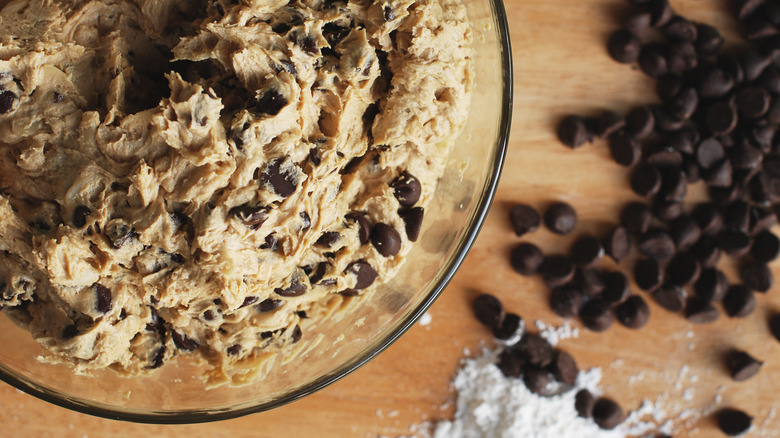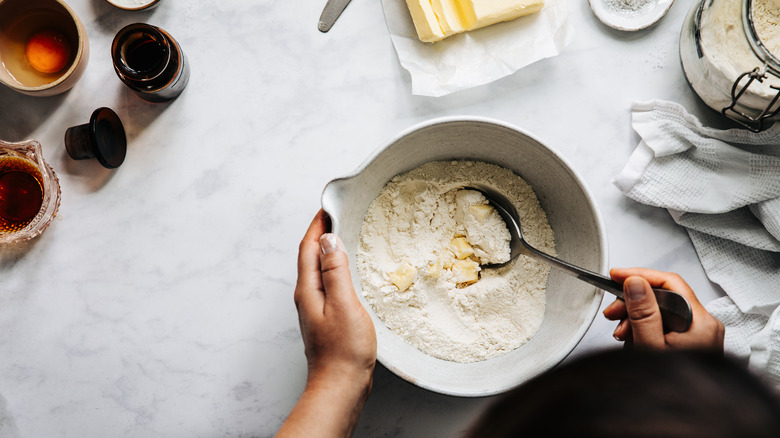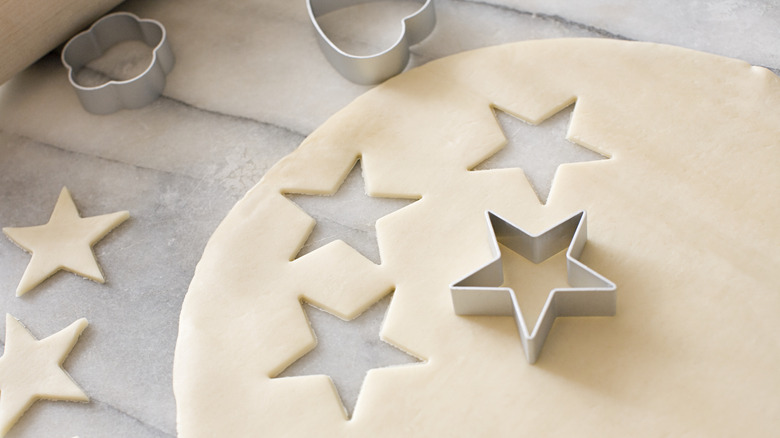Why Egg-Free Cookie Dough Is Still Unsafe To Eat Raw
Put down that spoonful of cookie dough or that whisk dipped in batter. While these uncooked treats may look absolutely tasty and positively harmless, you should think twice before taking a lick of uncooked batter or cookie dough. Yes, even if your dough is free from raw eggs, which may carry Salmonella, raw cookie dough still should not be consumed. This is because raw flour can also contain dangerous bacteria that can lead to food poisoning.
Even though one might not think of flour as raw food, it is not safe to eat straight out of the bag. This is due to the processing that flour goes through — including bleaching and milling — which does not kill potentially dangerous bacteria such as E. coli and Salmonella. These bacteria can cause serious illness if consumed. So, even if your dough does not contain raw eggs, you should probably skip taking a taste test if your flour is still raw.
However, this does not mean that there is no safe way to eat cookie dough. Heating the flour before adding it to your cookie dough can make your dough safe to eat, even without turning your dough into cookies. And since the market for edible dough has expanded, you can now buy edible dough kits and products that include heat-treated flour. Just make sure to look for an indication on the label that the product is safe to eat without cooking, as not all pre-packaged doughs and mixes are safe to consume.
Flour risks (and safety)
Though raw eggs are well-known as a vector for food-borne illnesses, raw flour is also unsafe to eat. The two primary bacteria that are known to contaminate flour are E. coli and Salmonella. Both bacteria can cause illnesses ranging from mild to severe. Young children, the elderly, immunocompromised people, and those who are currently pregnant are particularly at risk of severe illness when consuming raw flour.
For this reason, you should practice cooking safety when handling raw flour. And this goes beyond simply tasting your dough before baking. It is important to practice strict hygiene when cooking with flour. This includes washing your hands after handling dough and raw flour, cleaning surfaces on which the flour has been used, and thoroughly washing any utensils and bowls that have been potentially contaminated.
Additionally, it is vital to pay attention to recalls. You should dispose of any flour that has been recalled due to bacteria contamination. This is especially important to note because flour has a particularly long shelf life, and flour that may have been recalled could be on your shelf right now. Although cooking your flour should kill any contaminants, you will still want to dispose of anything impacted by recalls. You can visit the USDA website to look up any potential recalls on food, including flour and eggs.
Making a safer dough
This doesn't mean that you can't enjoy a scoop of a safely made dough. Several easy-to-make edible cookie dough recipes don't pose a food safety risk. You'll just have to make sure that the eggs are nixed from your recipe. In addition to this, you will want to heat your flour before putting it in your dough to avoid contamination.
To do this, simply place the flour in a thin layer on a baking sheet and place it in an oven, preheated to 300 degrees Fahrenheit. You'll want to heat your flour to 160 degrees Fahrenheit before ingesting. Alternatively, you can try the microwave method to make raw flour safe to eat. Simply heat it in 30-second intervals, checking the temperature after each round and removing it once it hits 160 degrees Fahrenheit. You will want to make sure that the flour isn't overcooked — as flour can potentially burn if heated for too long, or at too high a temperature.
You can also buy ready-to-eat cookie dough if you don't want to go through the process of heating your flour. Just make sure that the packaging on your dough indicates that it is, in fact, ready to eat — since not every tub and tube of cookie dough is automatically edible.


